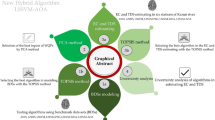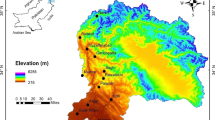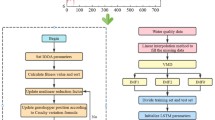Abstract
One of the essential indicators of surface water quality is total dissolved solids (TDS) that is prominent for both short- and long-term water resources management. In this study, in order to resolve the non-stationarity challenges faced by water quality parameters (WQPs), variational mode decomposition (VMD) combined with two unsupervised artificial intelligence (AI) models, artificial neural network (ANN) and extreme learning machine (ELM), was used. Crow search algorithm (CSA) was recruited to train the ANN and ELM networks and find the optimum weight and bias values. To validate the constructed hybrid VMD-ANN/ELM-CSA models, Molasani station in Karoon River was considered to model TDS at monthly timescale. The WQPs time-series data are simultaneously factorized into respective intrinsic mode functions (IMFs) using VMD algorithm. The proposed VMD-ELM-CSA model shows the best performance at considered station, in comparison with the comparative standalone and hybrid models, with maximum values of R2 = 0.97 and Ens = 0.96 at testing period. Results show that using VMD could reduce RMSE about 37 and 12% when coupled with ANN-CSA and ELM-CSA, respectively, at Molasani station. It was concluded that the CSA optimization algorithm and VMD data decomposition technique could improve the prediction accuracy of the AI models and may be recommended for accurate WQPs prediction.








Similar content being viewed by others
References
Abba SI, Pham QB, Usman AG, Linh NTT, Aliyu DS, Nguyen Q, Bach QV (2020) Emerging evolutionary algorithm integrated with kernel principal component analysis for modeling the performance of a water treatment plant. J Water Process Eng 33:101081
Adib A, Javdan F (2015) Interactive approach for determination of salinity concentration in tidal rivers (case study: the Karun River in Iran). Ain Shams Eng J 6(3):785–793
Ahmadianfar I, Jamei M, Chu X (2020) A novel hybrid wavelet-locally weighted linear regression (W-LWLR) model for electrical conductivity (EC) prediction in surface water. J Contam Hydrol 232:103641
Alizadeh Z, Yazdi J, Moridi A (2018) Development of an entropy method for groundwater quality monitoring network design. Environ Processes 5(4):769–788
Almási AD, Woźniak S, Cristea V, Leblebici Y, Engbersen T (2016) Review of advances in neural networks: neural design technology stack. Neurocomputing 174:31–41
Apaydin H, Feizi H, Sattari MT, Colak MS, Shamshirband S, Chau KW (2020) Comparative analysis of recurrent neural network architectures for reservoir inflow forecasting. Water 12(5):1500
Askarzadeh A (2016) A novel metaheuristic method for solving constrained engineering optimization problems: crow search algorithm. Comput Struct 169:1–12
Atiquzzaman M, Kandasamy J (2018) Robustness of extreme learning machine in the prediction of hydrological flow series. Comput Geosci 120:105–114
Ay M, Kisi O (2014) Modelling of chemical oxygen demand by using ANNs, ANFIS and k-means clustering techniques. J Hydrol 511:279–289
Baek SS, Pyo J, Chun JA (2020) Prediction of water level and water quality using a CNN-LSTM combined deep learning approach. Water 12(12):3399
Banadkooki FB, Ehteram M, Panahi F, Sammen SS, Othman FB, Ahmed ES (2020) Estimation of total dissolved solids (TDS) using new hybrid machine learning models. J Hydrol 587:124989
Bayatvarkeshi M, Imteaz MA, Kisi O, Zarei M, and Yaseen ZM. (2020) Application of M5 model tree optimized with Excel Solver Platform for water quality parameter estimation. Environ Sci Pollut Res, 1–18
Bhagat SK, Paramasivan M, Al-Mukhtar M, Tiyasha T, Pyrgaki K, Tung TM, Yaseen ZM (2021) Prediction of lead (Pb) adsorption on attapulgite clay using the feasibility of data intelligence models. Environ Sci Pollut Res 28(24):31670–31688
Das A, Das SS, Chowdhury NR, Joardar M, Ghosh B, Roychowdhury T (2020) Quality and health risk evaluation for groundwater in Nadia district, West Bengal: an approach on its suitability for drinking and domestic purpose. Groundw Sustain Dev 10:100351
Deo RC, Tiwari MK, Adamowski JF, Quilty JM (2017) Forecasting effective drought index using a wavelet extreme learning machine (W-ELM) model. Stoch Env Res Risk Assess 31(5):1211–1240
Dezfooli D, Hosseini-Moghari SM, Ebrahimi K, Araghinejad S (2018) Classification of water quality status based on minimum quality parameters: application of machine learning techniques. Model Earth Syst Environ 4(1):311–324
Dragomiretskiy K, Zosso D (2013) Variational mode decomposition. IEEE Trans Signal Process 62(3):531–544
Emamgholizadeh S, Kashi H, Marofpoor I, Zalaghi E (2014) Prediction of water quality parameters of Karoon River (Iran) by artificial intelligence-based models. Int J Environ Sci Technol 11(3):645–656
Fallah H, Kisi O, Kim S, Rezaie-Balf M (2019) A new optimization approach for the least-cost design of water distribution networks: improved crow search algorithm. Water Resour Manage 33(10):3595–3613
Feng ZK, Niu WJ, Tang ZY, Jiang ZQ, Xu Y, Liu Y, Zhang HR (2020) Monthly runoff time series prediction by variational mode decomposition and support vector machine based on quantum-behaved particle swarm optimization. J Hydrol 583:124627
Fijani E, Barzegar R, Deo R, Tziritis E, Skordas K (2019) Design and implementation of a hybrid model based on two-layer decomposition method coupled with extreme learning machines to support real-time environmental monitoring of water quality parameters. Sci Total Environ 648:839–853
Ghaemi A, Rezaie-Balf M, Adamowski J, Kisi O, Quilty J (2019) On the applicability of maximum overlap discrete wavelet transform integrated with MARS and M5 model tree for monthly pan evaporation prediction. Agric For Meteorol 278:107647
Ghasempour R, Azamathulla HM, Roushangar K (2021) EEMD-and VMD-based hybrid GPR models for river streamflow point and interval predictions. Water Supply 21(7):3960–3975
Gholami V, Khaleghi MR, Sebghati M (2017) A method of groundwater quality assessment based on fuzzy network-CANFIS and geographic information system (GIS). Appl Water Sci 7(7):3633–3647
Gupta D, Rodrigues JJ, Sundaram S, Khanna A, Korotaev V, and de Albuquerque VHC. (2018) Usability feature extraction using modified crow search algorithm: a novel approach. Neural Comput Appl, 1–11
He X, Luo J, Zuo G, **e J (2019) Daily runoff forecasting using a hybrid model based on variational mode decomposition and deep neural networks. Water Resour Manag 33(4):1571–1590
Herring T, Pidlisecky A, Cey E (2021) Removing the effects of temperature on electrical resistivity tomography data collected in partially frozen ground: limitations and considerations for field applications. Vadose Zone J 20(5):e20146
Huang GB, Zhu QY, Siew CK (2006) Extreme learning machine: theory and applications. Neurocomputing 70(1–3):489–501
Leong WC, Bahadori A, Zhang J, and Ahmad Z. (2019) Prediction of water quality index (WQI) using support vector machine (SVM) and least square-support vector machine (LS-SVM). Int J River Basin Manag, 1–8
Li G, Ma X, Yang H (2018) A hybrid model for monthly precipitation time series forecasting based on variational mode decomposition with extreme learning machine. Information 9(7):177
Liu W, Cao S, Chen Y (2016) Applications of variational mode decomposition in seismic time-frequency analysis. Geophysics 81(5):V365–V378
Liu C, Zhu L, Ni C (2018) Chatter detection in milling process based on VMD and energy entropy. Mech Syst Signal Process 105:169–182
Napolitano G, Serinaldi F, See L (2011) Impact of EMD decomposition and random initialisation of weights in ANN hindcasting of daily stream flow series: an empirical examination. J Hydrol 406(3–4):199–214
Niu WJ, Feng ZK, Chen YB, Zhang HR, Cheng CT (2020) Annual streamflow time series prediction using extreme learning machine based on gravitational search algorithm and variational mode decomposition. J Hydrol Eng 25(5):04020008
Olyaie E, Abyaneh HZ, Mehr AD (2017) A comparative analysis among computational intelligence techniques for dissolved oxygen prediction in Delaware River. Geosci Front 8(3):517–527
Parmar KS, Bhardwaj R (2014) Water quality management using statistical analysis and time-series prediction model. Appl Water Sci 4(4):425–434
Qasem SN, Samadianfard S, Kheshtgar S, Jarhan S, Kisi O, Shamshirband S, Chau KW (2019) Modeling monthly pan evaporation using wavelet support vector regression and wavelet artificial neural networks in arid and humid climates. Eng Appl Comput Fluid Mech 13(1):177–187
Rezaie-balf M, Naganna SR, Ghaemi A, Deka PC (2017) Wavelet coupled MARS and M5 Model Tree approaches for groundwater level forecasting. J Hydrol 553:356–373
Rezaie-Balf M, Kisi O (2018) New formulation for forecasting streamflow: evolutionary polynomial regression vs. extreme learning machine. Hydrol Res 49(3):939–953
Rezaie-Balf M, Naganna SR, Kisi O, El-Shafie A (2019a) Enhancing streamflow forecasting using the augmenting ensemble procedure coupled machine learning models: case study of Aswan High Dam. Hydrol Sci J 64(13):1629–1646
Rezaie-Balf M, Maleki N, Kim S, Ashrafian A, Babaie-Miri F, Kim NW, Alaghmand S (2019b) Forecasting daily solar radiation using CEEMDAN decomposition-based MARS model trained by crow search algorithm. Energies 12(8):1416
Rezaie-Balf M, Attar NF, Mohammadzadeh A, Murti MA, Ahmed AN, Fai CM, El-Shafie A (2020) Physicochemical parameters data assimilation for efficient improvement of water quality index prediction: comparative assessment of a noise suppression hybridization approach. J Clean Prod 271:122576
Sattari MT, Apaydin H, Band SS, Mosavi A, Prasad R (2021) Comparative analysis of kernel-based versus ANN and deep learning methods in monthly reference evapotranspiration estimation. Hydrol Earth Syst Sci 25(2):603–618
Sengorur B, Koklu R, Ates A (2015) Water quality assessment using artificial intelligence techniques: SOM and ANN—a case study of Melen River Turkey. Water Qual Expo Health 7(4):469–490
Singh B, Sihag P, Singh K (2017) Modelling of impact of water quality on infiltration rate of soil by random forest regression. Model Earth Syst Environ 3(3):999–1004
Song C, Yao L, Hua C, Ni Q (2021) A water quality prediction model based on variational mode decomposition and the least squares support vector machine optimized by the sparrow search algorithm (VMD-SSA-LSSVM) of the Yangtze River. China Environ Monitor Assess 193(6):1–17
Sun K, Rajabtabar M, Samadi S, Rezaie-Balf M, Ghaemi A, Band SS, Mosavi A (2021) An integrated machine learning, noise suppression, and population-based algorithm to improve total dissolved solids prediction. Eng Appl Comput Fluid Mech 15(1):251–271
Taghizadeh-Mehrjardi R, Schmidt K, Toomanian N, Heung B, Behrens T, Mosavi A, Scholten T (2021) Improving the spatial prediction of soil salinity in arid regions using wavelet transformation and support vector regression models. Geoderma 383:114793
Wang Y, Markert R, **ang J, Zheng W (2015) Research on variational mode decomposition and its application in detecting rub-impact fault of the rotor system. Mech Syst Signal Process 60:243–251
Wang M, Rezaie-Balf M, Naganna SR, Yaseen ZM (2021) Sourcing CHIRPS precipitation data for streamflow forecasting using Intrinsic time-scale decomposition based machine learning models. Hydrol Sci J 66(9):1437–1456
Zhang H, Nguyen H, Bui XN, Pradhan B, Mai NL, Vu DA (2021) Proposing two novel hybrid intelligence models for forecasting copper price based on extreme learning machine and meta-heuristic algorithms. Resour Policy 73:102195
Zuo G, Luo J, Wang N, Lian Y, He X (2020) Decomposition ensemble model based on variational mode decomposition and long short-term memory for streamflow forecasting. J Hydrol 585:124776
Author information
Authors and Affiliations
Corresponding author
Ethics declarations
Conflict of interest
The authors declared that they have no conflicts of interest to this study.
Rights and permissions
Springer Nature or its licensor (e.g. a society or other partner) holds exclusive rights to this article under a publishing agreement with the author(s) or other rightsholder(s); author self-archiving of the accepted manuscript version of this article is solely governed by the terms of such publishing agreement and applicable law.
About this article
Cite this article
Panahi, J., Mastouri, R. & Shabanlou, S. Influence of Pre-Processing Algorithms on Surface Water TDS Estimation Using Artificial Intelligence Models: A Case Study of the Karoon River. Iran J Sci Technol Trans Civ Eng 47, 585–598 (2023). https://doi.org/10.1007/s40996-022-00928-4
Received:
Accepted:
Published:
Issue Date:
DOI: https://doi.org/10.1007/s40996-022-00928-4




